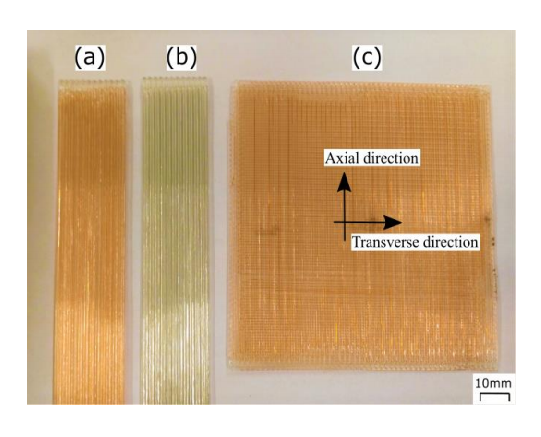Yehia Ibrahim, a thesis student at York University in Toronto, submitted a recent thesis regarding composites for 3D printing in ‘3D Printing of Continuous Wire Polymer Composite for Mechanical and Thermal Applications.’ Fiber reinforcement is becoming much more common in 3D printing today as a variety of different composites can improve structures significantly, depending on the initial material and desired structure.
 Different parameters can affect composites, however, such as the type of polymer used, fillers, and more. Here, the researchers experimented with adding metal wires to polymer matrixes to strengthen mechanical and thermal properties, resulting in better 3D printed structures. They also tested tensile and bending properties of the composites in comparison to the original polymers
Different parameters can affect composites, however, such as the type of polymer used, fillers, and more. Here, the researchers experimented with adding metal wires to polymer matrixes to strengthen mechanical and thermal properties, resulting in better 3D printed structures. They also tested tensile and bending properties of the composites in comparison to the original polymers
Popularity for polymer composites grows, due to benefits like:
- High stiffness
- High strength
- Low density
- Ease in manufacturing
Ibrahim points out that the range of composites being used today tend to improve 3D printed parts in both mechanical properties and structure overall, but many fillers present obstacles. Here, the research team attempts to use a continuous fiber to form ‘directional control.’
“From a structural standpoint, the continuous network ensures that the contribution of the fibers in the composite properties without being limited by the interfacial interaction between the fibers and the polymer,” states Ibrahim. “This will result in an increase in the mechanical properties of the printed components. From a thermal standpoint, the continuous network can act as a continuous thermally conductivity path for heat flow which aids the thermal conductivity of the composite.”
Overcoming any material challenges will allow expanded use in a variety of applications such as engineering, automotive, electrical, and more. While there are many different fibers and metal wires that can be used, up until now, research has been limited, including forays into Polyacrylonitrile (PAN) carbon fiber, aramid and glass fibers. And with such research, little studying has been performed regarding the effects of such materials on the composites once they are added.
Considering issues such as affordability, the bottom line is much better when labs can create or make use of open-source printers, especially with 3D printing continuous fiber polymer composites (CFPCs) which offer a stable network to maintain reinforcement properties.
“The use of open source printer can also significantly reduce the total cost of the fabrication process. Finally, 3D printed CFPCs have a great potential to be used in more than just mechanical and thermal property enhancement,” states Ibrahim. “The continuous fiber network can act as a sensory element for mechanical stresses, heat flux, temperature and other sensing. It can also be used as an active element to enable the fabrication of 3D printed structures with embedded heating elements to be used in low temperature heating applications.”
The research team used an open-source Prusa mk3 i3 for their research, customized for fabrication of various polymers with the embedded metal wire. The 3D printer required customizing so the wire could be inserted into the filament directly before extrusion.
Evaluation of the mechanical properties showed ‘superior performance.’ The research team based their comparisons on the original polymers, examined the level of improvement, which was obviously quite significant. The addition of nickel chromium wire showed an improvement of up to 50 percent.
“The technique was also used to printed CPWC samples and provided good agreement with the experimental results,” concluded Ibrahim. “The technique developed herein was also used to 3D print a CWPC heating element which were then used to fabricate a low-temperature heater panel. These 3D printed heated panels were field-tested on board a navy ship sailing in the arctic circle.”
“The panel was able to maintain its surface ice free at different water loading conditions. In addition, with combining with hydrophobic coating, the consumed energy of the panels was reduced significantly.”
Researchers, engineers, and designers around the world are learning they have many more options with the creation and use of composites, from PG/PLA to flax fiber, wood, and far more. What do you think of this news? Let us know your thoughts! Join the discussion of this and other 3D printing topics at 3DPrintBoard.com.
[Source / Images: ‘3D Printing of Continuous Wire Polymer Composite for Mechanical and Thermal Applications’]Subscribe to Our Email Newsletter
Stay up-to-date on all the latest news from the 3D printing industry and receive information and offers from third party vendors.
You May Also Like
3D Printing News Briefs, April 13, 2024: Robotics, Orthotics, & Hypersonics
In 3D Printing News Briefs today, we’re focusing first on robotics, as Carnegie Mellon University’s new Robotics Innovation Center will house several community outreach programs, and Ugogo3D is now working...
Rail Giant Alstom Saves $15M with 3D Printing Automation Software 3D Spark
3D Spark has entered into a three-year deal with the rail giant Alstom. Alstom, a transport behemoth with annual revenues of $16 billion, specializes in the manufacture of trains, trams,...
Meltio Expands Global Reach with New Partnerships in the Americas and Europe
Spanish 3D printing manufacturer Meltio has expanded its sales network across the globe. With the addition of three new partners in the United States, Brazil, Argentina, and Italy, Meltio aims...
3D Printing Webinar and Event Roundup: April 7, 2024
Webinars and events in the 3D printing industry are picking back up this week! Sea-Air-Space is coming to Maryland, and SAE International is sponsoring a 3D Systems webinar about 3D...


































